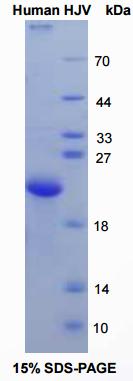
血幼素(HJV)重组蛋白
产品名称: 血幼素(HJV)重组蛋白
英文名称: Recombinant Hemojuvelin (HJV)
产品编号: YB995Ra011
产品价格: 0
产品产地: 中国/美国
品牌商标: 钰博生物/Ybscience
更新时间: 2023-08-17T10:29:50
使用范围: null
- 联系人 : 陈环环
- 地址 : 上海市沪闵路6088号龙之梦大厦8楼806室
- 邮编 : 200612
- 所在区域 : 上海
- 电话 : 183****2235 点击查看
- 传真 : 点击查看
- 邮箱 : shybio@126.com
- 二维码 : 点击查看
血幼素(HJV)重组蛋白
YB995Ra011
Hemojuvelin (HJV)
Organism: Homo sapiens (Human)
Instruction manual
FOR IN VITRO USE AND RESEARCH USE ONLY
NOT FOR USE IN DIAGNOSTIC OR THERAPEUTIC PROCEDURES
4th Edition (Revised in February, 2012)
血幼素(HJV)重组蛋白[ DESCRIPTION ]
 Protein Names: Hemojuvelin
Protein Names: Hemojuvelin
Synonyms: HFE2, HJV, RGMC
Species: Human
Size: 100µg
Source: Escherichia coli-derived
Subcellular Location: Secreted.
血幼素(HJV)重组蛋白[ PROPERTIES ]
Residues: Lys234~Ser416 (Accession # Q6ZVN8), with N-terminal His-Tag.
Grade & Purity: >95%, 22 kDa as determined by SDS-PAGE reducing conditions.
Formulation: Supplied as lyophilized form in PBS, pH 7.4, containing 0.01% Sarcosyl,
5% sucrose.
Endotoxin Level: <1.0 EU per 1µg (determined by the LAL method).
Applications: SDS-PAGE; WB; ELISA; IP.
(May be suitable for use in other assays to be determined by the end user.)
Predicted Molecular Mass: 20.96 kDa
Predicted isoelectric point: 5.36
Human HJV kDa
70
44
33
27
18
14
10
15% SDS-PAGE
[ PREPARATION ]
Reconstitute in sterile PBS, pH7.2-pH7.4.
血幼素(HJV)重组蛋白[ STORAGE AND STABILITY ]
Storage: Avoid repeated freeze/thaw cycles.
Store at 2-8oC for one month.
Aliquot and store at -80oC for 12 months .
Stability Test: The thermal stability is described by the loss rate of the target protein. The loss rate was
determined by accelerated thermal degradation test, that is, incubate the protein at 37oC or 48h, and no obvious
degradation and precipitation were observed. (Referring from China Biological Products Standard, which was
calculated by the Arrhenius equation.) The loss of this protein is less than 5% within the expiration date under
appropriate storage condition.
[ SEQUENCES]
The target protein is fused with N-terminal His-tag, its sequence is listed below.
MGHHHHHHSGSEF-KVYQAEVDNLPVAFEDGSINGGDRPGGSSLSIQTANPGNHVEIQAAYIGTTIIIRQTAGQLS
FSIKVAEDVAMAFSAEQDLQLCVGGCPPSQRLSRSERNRRGAITIDTARRLCKEGLPVEDAYFHSCVFDVLISGD
PNFTVAAQAALEDARAFLPDLEKLHLFPSDAGVPLSSATLLAPLLS
[ REFERENCES ]
1. Papanikolaou G.,et al. (2004) Nat. Genet. 36:77-82.
2. Ota T., et al. (2004) Nat. Genet. 36:40-45.
3. Gregory S.G., et al. (2006) Nature. 441:315-321.
4. Lanzara C., et al. (2004) Blood. 103:4317-4321.
